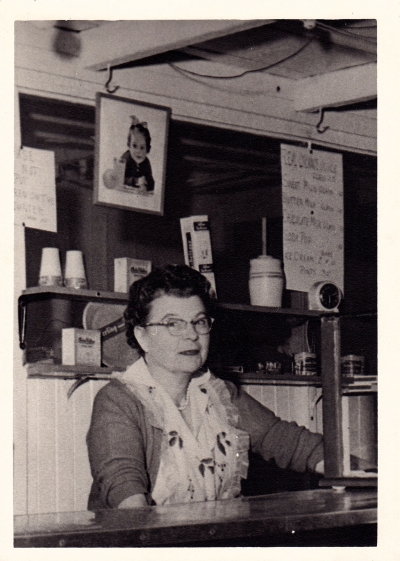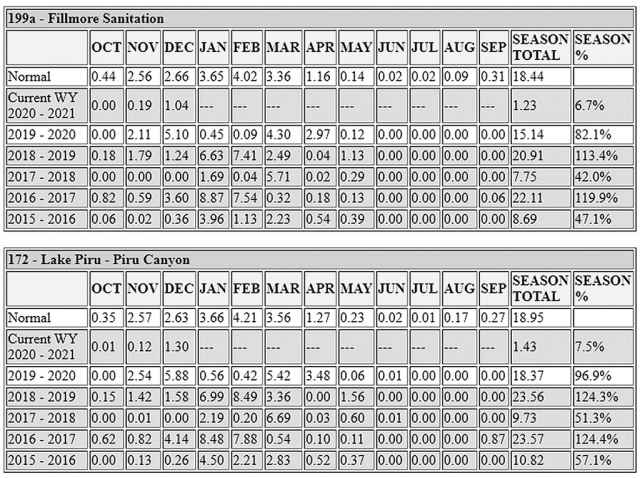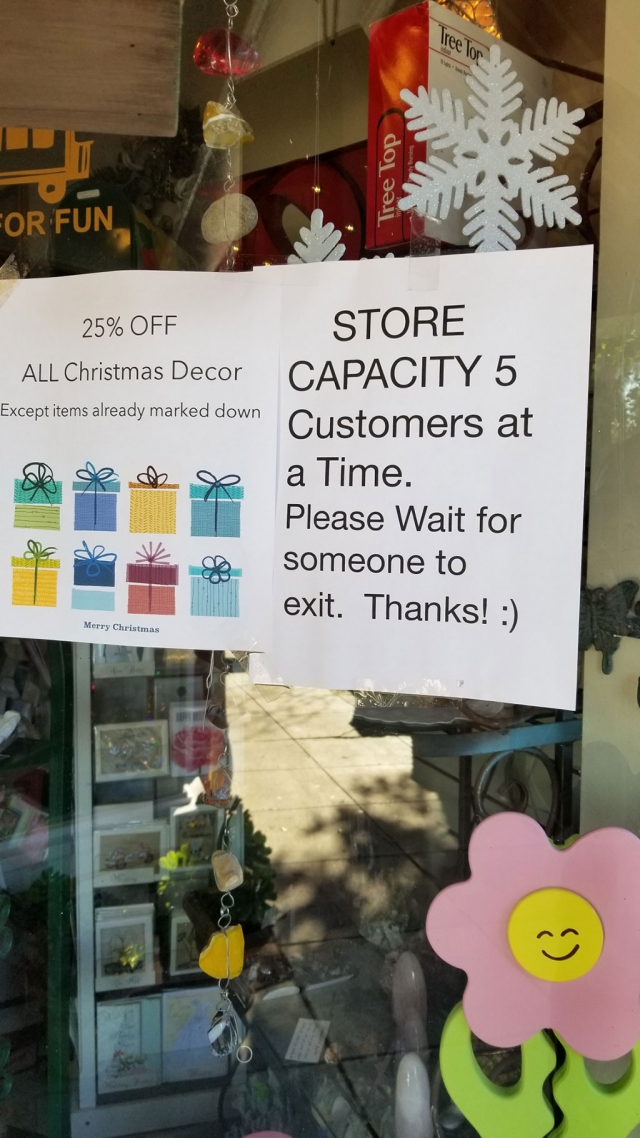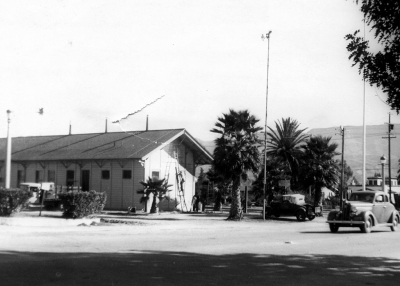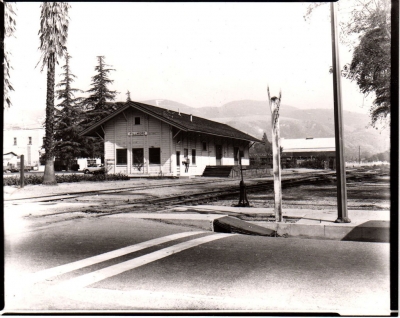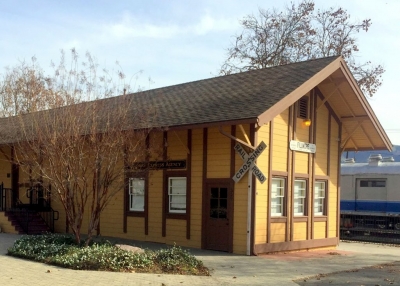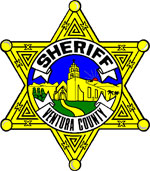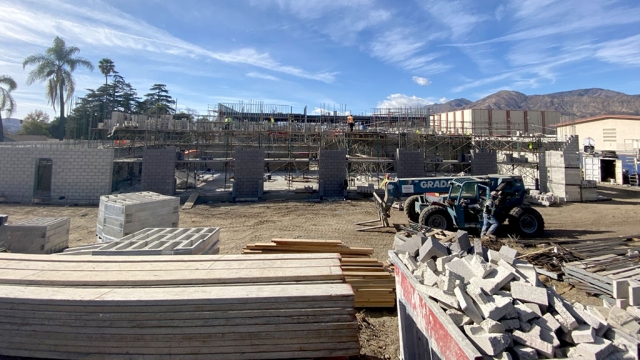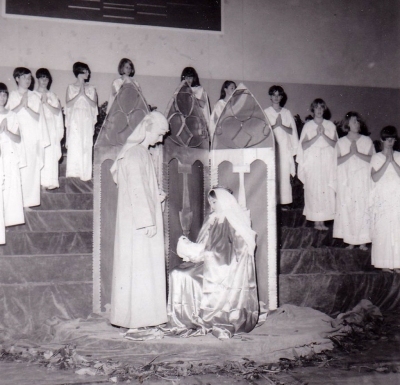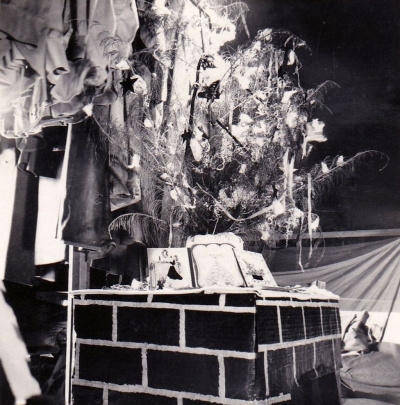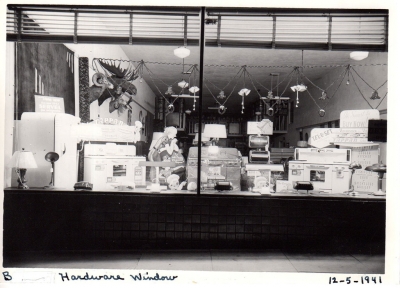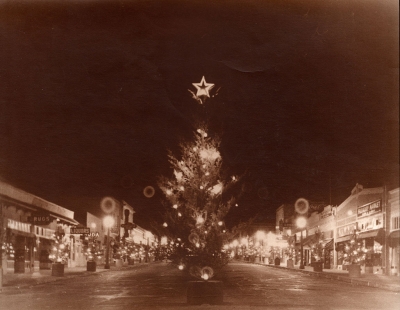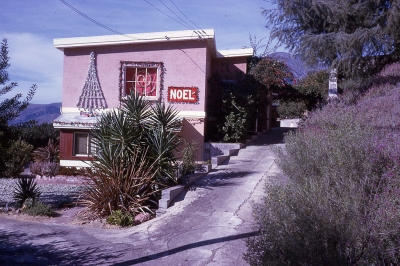|
By Anonymous — Wednesday, January 6th, 2021
Michael Lara passed away last weekend after a short battle with Covid. Michael was loved by so many in Fillmore and Santa Paula, where he kept his home. For years his beautiful voice and organ playing could be heard each week at Fillmore's St. Francis Catholic Church and St. Sebastian's in Santa Paula. He was the foundation for many of the programs at St. Francis and his contributions are irreplaceable. Michael was a true friend to so many and his passing leaves a sad void. He loved his Lord and Savior Jesus Christ without measure and is now reunited with his beloved mother and father. Well done thou good and faithful servant. |
|
By Anonymous — Wednesday, January 6th, 2021
 Starbucks was closed last on Thursday, December 31st, when a gas leak was discovered outside Little Caesar’s Pizza next door. It reopened the next day. Fillmore Starbucks had cut its hours recently, closing at 1PM, but returned to normal hours on January 6th. Enlarge Photo |
|
By Anonymous — Wednesday, January 6th, 2021
On December 30th the California COVID Relief small business and non-profit grant program opened up to accept applications. Grants range from $5,000 to $25,000 and can be used to pay for an establishment’s rent, utilities, resources, employee expenses and other relevant costs. The deadline to apply for the first round is midnight on Friday, January 8, 2021. For additional information please visit https://careliefgrant.com. Courtesy City of Fillmore https://www.fillmore ca.com/Home/Components/News/News/3302/18 Post Date:12/30/2020. |
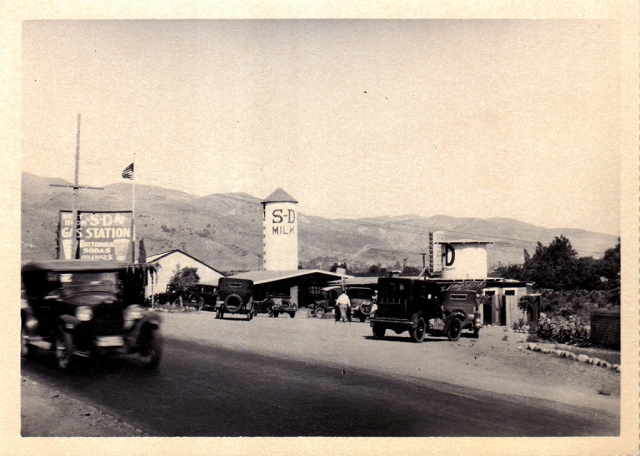 The Sanitary Dairy taken in 1920, which was founded by Elvira and Clifford Hardison in 1916. The dairy is located on Old Telegraph Road in Fillmore and declared a County Landmark by the County Board of Supervisors in 1989. Photos courtesy Fillmore Historical Museum. Enlarge Photo By Anonymous — Wednesday, January 6th, 2021
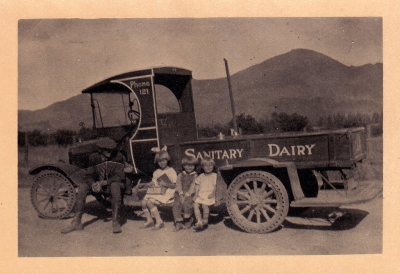 Sanitary Dairy truck in 1925, with Cliff, Dorothy, Russell and Evelyn Hardison sitting on the truck. Children would jump on and off the running boards to deliver milk. Enlarge Photo Courtesy Fillmore Historical Museum The local dairy was founded in 1916 by Elvira and Clifford Hardison. Clifford Hardison was the resident manager on the Hardison Ranch Company’s La Campana property in Sespe when the young couple decided to start their own farm properties. When the nearby highway was realigned south from Muir, they then bought 10 acres on “Telegraph Road”. They bought cows (some from other local farmers) and started a herd of about 30. A modern milking barn and milk handling room were built to plans from the University of California. A prefabricated grain silo was purchased from Sears and set up on site. It was topped with an arrow and large wooden milk bottle and painted “SD”, signage that could be seen from the highway. A hay barn and corrals housed the cattle. The name “Sanitary” meant the cows were certified as healthy and the raw milk handled according to all regulations. It was carefully chilled, put into glass bottles and promptly deliver by twice-daily routes throughout the area – as fresh as it could be! Elvira Hardison opened a stand alongside the dairy and offered fresh-squeezed orange juice from their trees and dairy products from the cows that were milked where the public could watch. Homemade sandwiches and candies, sodas and other items were for sale. A small gas station, restrooms and shaded picnic area made the place a popular stop for locals and travelers approaching Fillmore. The dairy prospered and expanded over the years. Their children all worked at dairy chores. Dorothy Hardison Nickerson recalled that she and her brother Russ ran to deliver bottles to doorsteps as Cliff or Elvira drove the delivery truck. Daughters Evelyn Hardison Richardson and Betty Jean Hardison Burritt helped to prepare food and staff the stand. Days were long and very busy. They recalled a record day during the depression when sales reached $100! Russell Hardison got his college degree in Dairy Science from UC Davis. After his wartime service he returned and took of the retail part of the dairy in 1946 and eventually became owner of the whole business. The herd was expanded further to 60 cows and a new Creamery building went up in 1948 to accommodate equipment for pasteurization and more bottling capacity. Schools wanted pasteurized milk, and the baby-boomer generation filled the schools. Routes now went out to Piru and Santa Paula and beyond. The highway was realigned again south in 1956, leaving now on “Old Telegraph Road.” Elvira saw that it was time to close the roadside stand after 40 years of good business. Through the 50’s, 60’s, 70’s and beyond, owners Russell and Betty Hardison were active in the community – supporting local causes, entering floats in the annual Fillmore parade, and hosting many, many local school children on field trips to the dairy. Children could watch as the cows were milked, could pet baby calves, and drink some chocolate milk while wearing SD beanies! Because of decreased demand for home delivery, routes were discontinued. Sales then concentrated on serving schools. The dairy cows left about that time, but the buildings remained. Russ Hardison had milk bottled in up in his brands at other local dairies and actually owned school delivery routes until the early 1980’s. The Hardison home and the dairy buildings on Old Telegraph Road are now used for other purposes. The Ventura County Board of Supervisors declared the Sanitary Dairy to be a County Landmark in 1989. |
 On December 21st a traffic collision was reported on Highway 126 near E Street in Fillmore. A white SUV veered off the road through some bushes, took out the Jim’s Fillmore Towing sign and struck a parked Nissan Sentra. Upon later investigation the driver was arrested for driving under the influence. Enlarge Photo By Ventura County Sheriff Department — Wednesday, December 30th, 2020
On December 21, 2020, deputies assigned to the Fillmore Police Department responded to a traffic collision in the vicinity of Ventura and E Streets in Fillmore. Their investigation determined (S) Javier Almaraz had been driving while under the influence of alcohol and had collided with an Edison power pole; street, speed limit, and business signs; landscaping; a parked, unoccupied car; and a chain link fence. He was subsequently arrested for driving under the influence of alcohol. Shortly before 9:00 PM Monday night, a witness called 9-1-1 to report a reckless driver on Highway 126. Before Fillmore deputies could find the vehicle, however, it was involved in a collision at Ventura and E Streets. The investigation determined the driver, (S) Javier Almaraz, had originally been seen swerving in and out of his lane while westbound on Highway 126 from the Ventura/Los Angeles County line. Almaraz was reported to have driven on the wrong side of the four-lane highway and run a red light at B Street, as well. Almaraz was found to have been driving with a blood alcohol content (BAC) of more than twice the legal limit of .08%. Almaraz, who was uninjured in the collision, was subsequently arrested for § 23152(a) and (b) of the California Vehicle Code, both misdemeanor DUI charges, and booked at the Pre-Trial Detention Facility with a bail of $5,000. In an effort to prevent traffic collisions, the Fillmore Police Department recently received a grant from the California Office of Traffic Safety and is utilizing these funds to actively seek and arrest motorists driving under the influence of alcohol and/or drugs. It is extremely fortunate that this collision did not involve any other people, and no one was injured or killed as a result of Almaraz’ decision to drive while under the influence of alcohol. The members of the public who called to report his reckless driving and the collision are commended for their efforts, and the Fillmore Police Department encourages anyone witnessing unsafe driving to call 9-1-1 and help save lives. Nature of Incident: Reckless driver call ends with non-injury traffic collision, DUI arrest |
|
By Anonymous — Wednesday, December 30th, 2020
 Early Monday, December 28th, the rain and winds came through town in full force. With heavy rain and winds on and off throughout the day Fillmore received .63 inches of rain. Above are the current rainfall totals for Fillmore and Piru from the Ventura County Public Works Agency Watershed Protection District Hydrology Section Season Rainfall Summary Report as of December 29th. See page 3 for more rain totals for Fillmore and Piru for monthly rainfall summary. For updates visit https://www.vcwatershed.net/fws/AutoMedia.htm. Enlarge Photo |
|
By Anonymous — Wednesday, December 30th, 2020
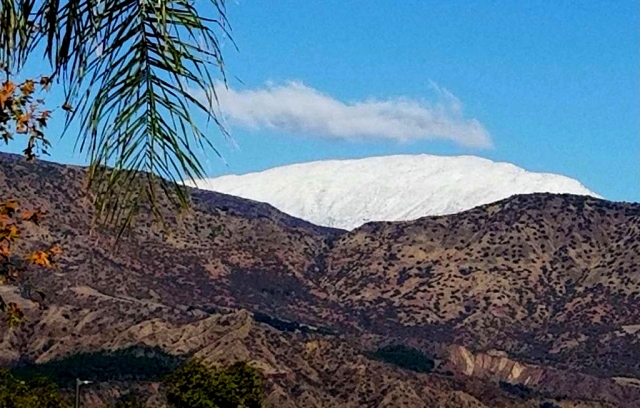 Beginning early Monday morning into the evening a rainstorm blew through Ventura County bringing heavy rains and winds, but it left behind Christmas week snow on the Sespe Mountain Range. Enlarge Photo |
|
By Anonymous — Wednesday, December 30th, 2020
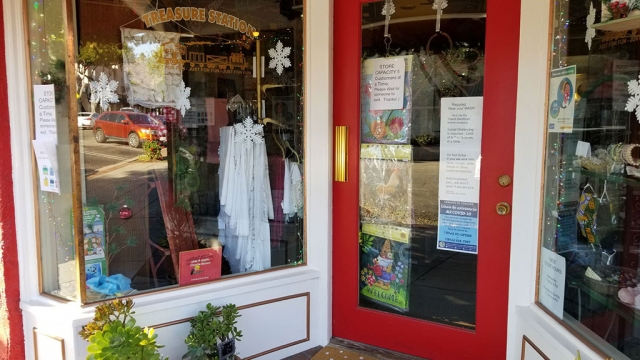 The impact of COVID-19 has created changes to shops in downtown Fillmore, such as posting multi-signs in windows and limiting the number of customers in-store at one time. For example, small stores like the Treasure Station have signs in their windows stating “Store Capacity 5 Customers at a Time, Masks Required” or “Please Wash Your Hands” that are now common to see as you walk down Central Avenue. Enlarge Photo |
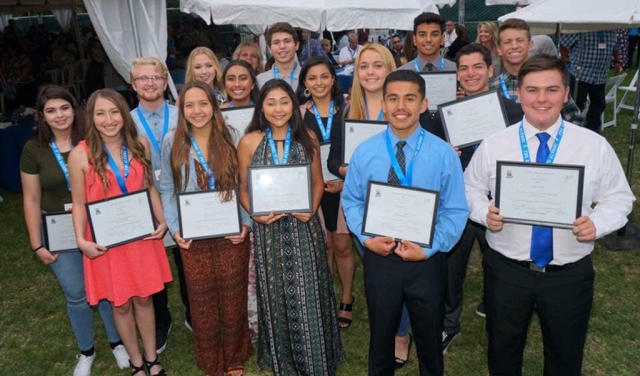 Every year the Fillmore High School Alumni Scholarship Foundation gives thousands of dollars in scholarships to local Fillmore students. Pictured above are some of their past scholarship winners. Now the FHS Alumni Scholarship Foundation is asking the community to help with this coming year’s donations. Enlarge Photo By Anonymous — Wednesday, December 30th, 2020
As a registered 501c3 organization, the Fillmore High Alumni Association welcomes all donations to their Scholarship Foundation. This year, we hope you consider a donation to their Scholarship program so that the Association can continue awarding Education Scholarships, and Continuing Education Grants to our Fillmore High Graduates. You can donate here, right now by clicking on this link, http://www.fillmorehighalumni.com/donate or if your in the Fillmore area, you can drop off a check through their mail slot on the front door of their office at 559 Sespe Ave. All donation amounts are welcomed. (Our Tax ID number will be provided) Thank you in advance for your continued support in helping us, help our Fillmore High Graduates!! Onward and Upwards!! |
|
By Anonymous — Wednesday, December 30th, 2020
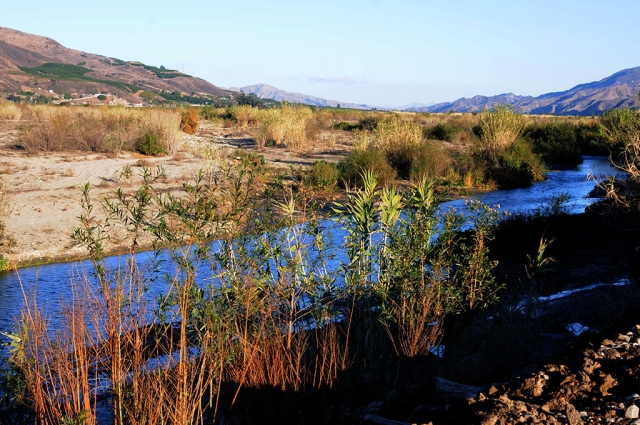 The Santa Clara River is flowing more than usual after Fillmore got a much need rain this past Monday, December 28th. Enlarge Photo |
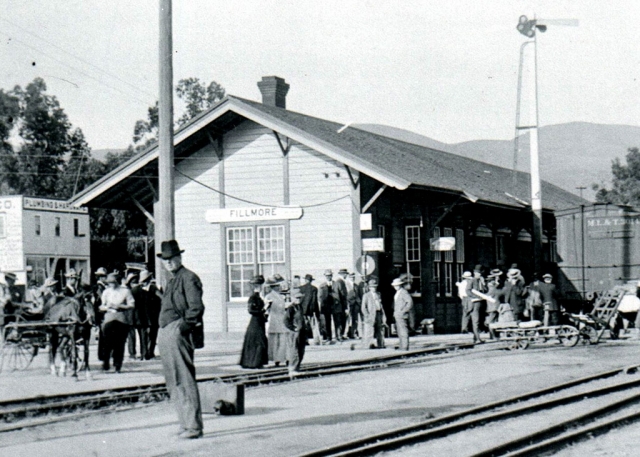 The Fillmore Train Depot back in 1910 during its heyday. Photos courtesy Fillmore Historical Museum. Enlarge Photo By Anonymous — Wednesday, December 30th, 2020
Courtesy Fillmore Historical Museum Seventy-five years ago, Fillmore and the rest of the world were just coming out of one of the worst series of events man had ever known – the Great Depression and World War II. Here is an excerpt from an article written in January, 1946, about our town by an unknown author. “During the war everybody was expected to concentrate on winning for our side – and quite properly so. But now that the war is over – theoretically at least – it would seem the part of wisdom to get busy, total up our prospects, and get going in high gear as soon as is humanly possible. Suppose we start with buildings – both business and residential… There are some buildings that must be torn down to make way for progress… Why do we continue to tolerate the ancient edifice which is called by courtesy a railroad station? That rambling old wreck was built just after the Civil War, and is not getting any younger. When rain comes, the water naturally seeks the lowest level, which means that a good-sized pond is in evidence under the station floor for many days after each rain. The net result is rotting underpinning, so that when people walk into the depot they cannot be sure the floor will not give way and thus endanger life and limb. From the amount of business, the (rail) road enjoys, it would seem at least that could be done would be a station which would be a credit to the railroad as well as the community. Looks like a very proper function for the Chamber of Commerce would be to storm the railroad offices and keep storming them until something is done about the deplorable condition. Los Angeles has become so big that it is no place for people to live – so that many a business man has his business in Los Angeles, while his home is somewhere in the suburbs. Pretty soon many a Los Angeles business man will own a helicopter – and he will establish his home in Fillmore or some other suburban spot located in the fresh air zone. It will be a matter of ten or fifteen minutes to get home to Fillmore after closing hours…” Well, not everything has come to pass quite as was predicted in 1946. The railroad didn’t improve the depot; instead it was closed and later sold to Edith Moore Jarrett for $1.05. It was moved and renovated to become the home of the Fillmore Historical Museum. In 1995 it was moved back near the tracks a little east of its original location. Even though the depot is not in the same location as it was in 1946, when it rains, water does accumulate beneath it – but now there is a very effective sump pump. We do have helicopters flying over the town, but not for commuting business men. Not every businessman has his own helicopter, but with better roads and the move to telecommuting, Fillmore has become attractive to commuters, as can be seen with all the houses under construction. And the railroad has become a tourist attraction. We now enjoy the whistles and the sounds of the steam engine which reminds us of how it used to be all those years ago when the depot was the center of activity in town. |
|
By Anonymous — Wednesday, December 23rd, 2020
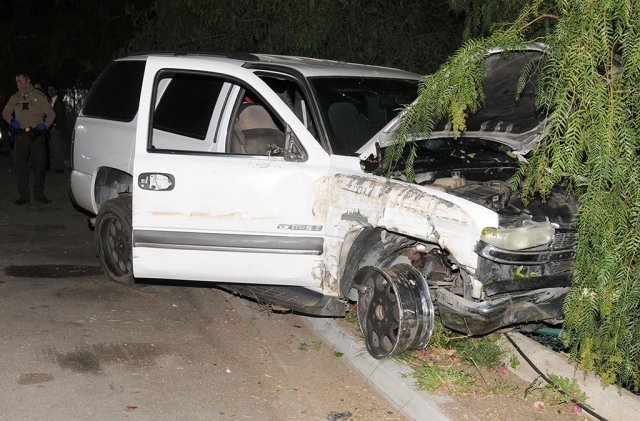 On Monday, December 21st at 9:15pm a crash occurred at E Street and Highway 126 near Jim’s Fillmore Towing. A white Tahoe was traveling west bound on Highway 126 when it off the highway, through the bushes, taking out part of the Jim’s Fillmore Towing sign and hitting the back end of a parked Nissan Sentra. Nobody was in the Sentra at the time of the crash. The driver of the Tahoe was traveling alone and was examined at the scene. Cause of the crash is still under investigation. Enlarge Photo |
|
By Ventura County Sheriff Department — Wednesday, December 23rd, 2020
On 12/10/20, at approximately 7:26 PM, deputies assigned to the Fillmore Police Station responded to a report of an injured person walking in the 1100 block of Ventura Street. Upon arrival, the deputies contacted an adult male and determined he had been stabbed multiple times. The man was in need of immediate medical assistance and was transported, via ambulance, to a local hospital where he was stabilized with serious injuries. During the course of the investigation, detectives determined the victim had been assaulted before he was transported by vehicle from the 1100 block of El Paseo Street in Fillmore to the area where he was contacted on Ventura Street. Detectives are seeking any witnesses or potential video surveillance footage of the vehicle, suspect(s), or the assault itself. If anyone has information regarding the incident, they are encouraged to contact Detective Javier Chavez, with the Sheriff’s Major Crimes Bureau, at 805-384-4725. Community: Fillmore Shooting - Request for Public Assistance Ventura County Crime Stoppers will pay up to $1,000 reward for information, which leads to the arrest and criminal complaint against the person(s) responsible for this crime. The caller may remain anonymous. The call is not recorded. Call Crime Stoppers at 800-222-TIPS (8477). |
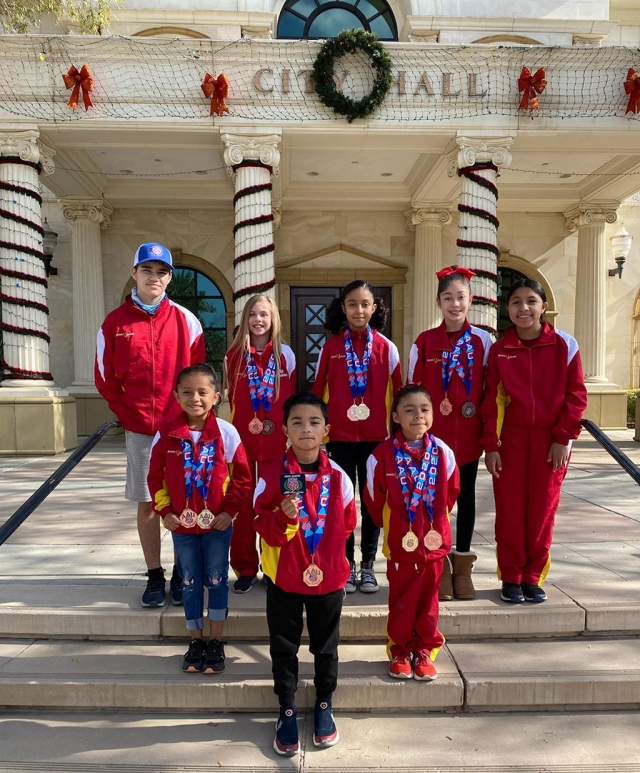 On Saturday, December 5th, the Fillmore Youth Cross-Country Team, the Shockwaves, traveled to Tallahassee, Florida to compete in the Amateur Athletic Union National Cross-Country Championships. Pictured above is the Shockwaves tea: left to right-back row: Joshua Estrada, Julie Bakholdin, Emily Arriaga, Paola Estrada, and Niza Laureano. Front row: Aaliyan Tarango, Mason Arriaga, and Leah Laureano. Enlarge Photo By Anonymous — Wednesday, December 23rd, 2020
Local Fillmore youth cross country runners competed at the Amateur Athletic Union (AAU) National Cross Country Championships in Tallahassee, Florida on Saturday, December 5th. The group of local athletes competed and qualified for the event with the team known as the Pacific Coast Shockwaves which represent athletes from Fontana, Los Angeles, San Pedro, Victorville and Ventura County. The team is coached locally by Maria Elena Alcantara, Evelio Arriaga, Daniel Bakholdin, Israel Estrada, Temo Laureano, Juan Ruiz, Cynthia Tarango, and Juan Toledo. For more information on the team please call or text: 805-421-8741 or 805-258-3821. The results are as follows: Mason Arriaga, 4:12.46, Boys 1k Race: 6 years old & under, placed 15th overall out of a field of 50 runners, earned All American Honors, placing 7th in his age group. Julie Bakholdin, 11:43.08, Girls 3k Race: 11 - 12 year olds, placed 62nd overall out of a field of 240 runners, placing 21st in her age group, with her Shockwave team placing 3rd. Joshua Estrada, 14:28.79, Boys 4k Race: 13 - 14 year olds, placed 156th overall out of a field of 245 runners, placing 94th in his age group, with his Shockwave team placing 5th. Paola Estrada, 11:00.59, Girls 3k Race: 11 - 12 year olds, placed 15th overall out of a field of 240 runners, earned All American Honors, placing 4th in her age group, with her Shockwave team placing 4th. Leah Laureano, 8:55.25, Girls 2k Race: 7 - 8 year olds, placed 19th overall out of a field of 59 runners, earned All American Honors, placing 6th in her age group, with her Shockwave team placing 1st as National Champions. Niza Laureano, 15:43.42, Girls 4k Race: 13 - 14 year olds, placed 104th overall out of a field of 214 runners, placing 45th in her age group, with her Shockwave team placing 4th. Aaliyan Tarango, 8:49.25, Girls 2k Race: 7 - 8 year olds, placed 15th overall out of a field of 59 runners, earned All American Honors, placing 11th in her age group, with her Shockwave team placing 1st as National Champions. |
|
By Anonymous — Wednesday, December 23rd, 2020
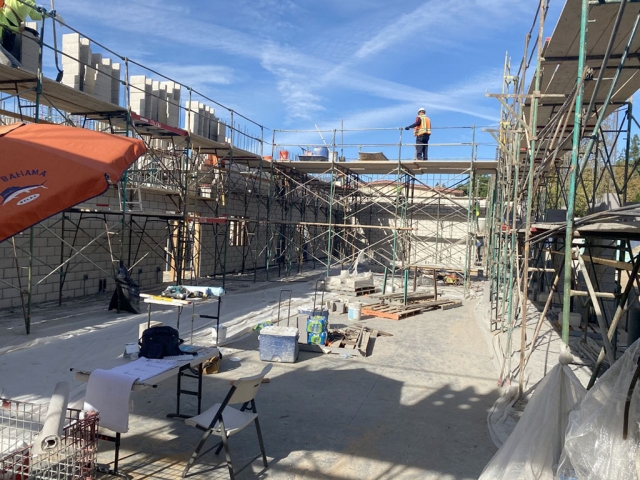 Fillmore High began construction on their Career Technology Education (CTE) building sin the summer/fall of 2019. The plans are to build an Agricultural and Transportation SDSR (SDSR Systems Diagnostic Service and Repair) building. Above is the Transportation Building construction underway; the buildings expected completion date is July 2021. Enlarge Photo |
|
By Anonymous — Wednesday, December 23rd, 2020
Brett Battles, bestselling author of nearly 40 novels, has moved to Fillmore. Born and raised in Ridgecrest, California, Battles lived most of his life in the greater Los Angeles area, but felt ready for a change. "I was looking for a place outside of Los Angeles, but close to Simi Valley, where my kids live," said Battles. "Ventura County seemed like the perfect solution. I checked out several places, and really liked the feel and size of Fillmore. Plus, one of my best friends lives here, so that was a bonus." Battles has sold over one million copies of his novels. He is a USA Today bestselling author of several series including the Jonathan Quinn series, the Project Eden series, and the time bending Rewinder trilogy. His debut novel, The Cleaner (A Jonathan Quinn Novel Book 1), was nominated for The Barry Award for Best Thriller, and The Shamus Award for Best First Novel. His second Jonathan Quinn novel, The Deceived, won The Barry Award for Best Thriller. Battles has traveled extensively to many international cities, Ho Chi Minh City, Berlin, Bangkok, Angkor Wat, Singapore, Jakarta, London, Paris, and Rome, all play parts in his current and upcoming novels. Although he enjoys traveling, Battles loves being at home to write and spend time with his three adult children, Ronan, Fiona, and Keira, who now enjoy driving up to Fillmore for visits and to play with Maggie, Brett's neurotic, paranoid, and very cute, Australian Shepherd. "I love the pace of Ventura County. It’s both energetic and relaxed, perfect for me. I feel like I’ve lived in Fillmore for years. It really feels like home. I’ve made some great friends here already, and look forward to making even more." Battles says, "If you like James Bond, Jack Reacher, or Jason Bourne, give my Jonathan Quinn series a try. I get the best feedback from Quinn fans. They seem to really love the main characters." Battles latest Quinn novel, The Vanished, was just released this December and has already reached #1 in several Mystery, Thriller, and Suspense categories on Amazon. You can lean more about Battles and his novels at his website www.brettbattles.com |
|
By Anonymous — Wednesday, December 23rd, 2020
During this time we would like to remember and honor those in our community. Santa Clara Valley Hospice has been sponsoring Light Up a Life for over 27 years. There is still time to make a $10 donation to add the name of a loved one. Contact: SCVH at 805.525.1333. IN MEMORY OF... In Honor of: |
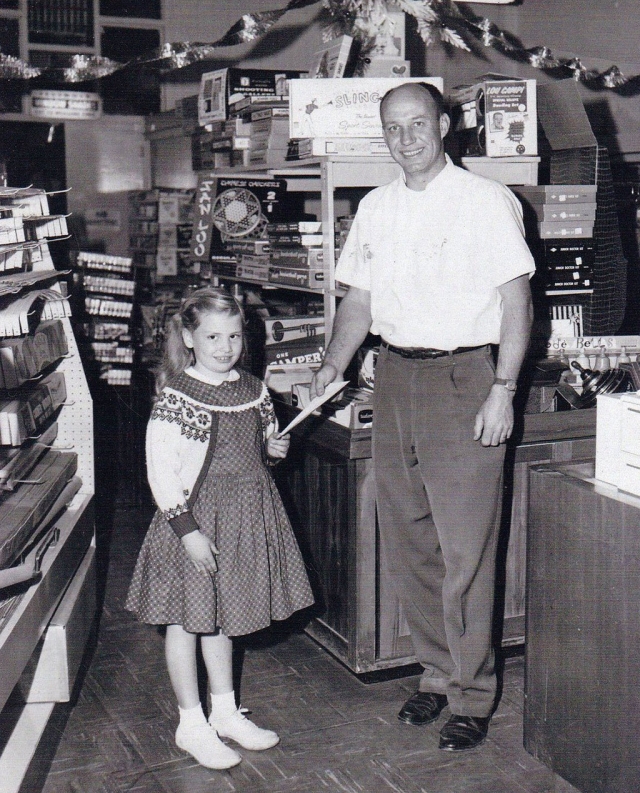 1960 Stockers Department Store Bill Stocker and Susan French. Photos courtesy Fillmore Historical Museum. Enlarge Photo By Anonymous — Wednesday, December 23rd, 2020
Courtesy Fillmore Historical Museum Christmas is always an exciting time for children and their families. The children eagerly await the arrival of Santa and presents. Their parents spend an outrageous amount of time and money buying presents and attempting to hide them until late Christmas Eve when they can be placed under the tree for the children to find in the morning. Fillmore’s local merchants tried to outdo each other with festive store windows. The only newspaper in Fillmore added to the festivities with special, colorful, Christmas front pages. The photo of the front page from 1911 shows Santa, having swapped his sleigh for the newest invention, an airplane, dropping toys and candy to the children below. Christmas in the early years of the twentieth century were less complicated. There might be a small tree such as the one in the photo from 1913, decorated with popcorn strings, some tinsel, ribbons and a few presents. The piano was close by to allow for singing carols as the children impatiently waited for Santa to arrive. Sometimes there were parties where the children received an orange from California or piece of hard candy. In 1930 Fillmore celebrated with lighted Christmas trees placed in concrete pots down both sides of Central Avenue as well as trees in the center of the street placed at each crosswalk. These were all live trees as were all the trees for sale in every grocery store in town. There were at least 5 grocery stores on Central Ave with trees for sale out front on the sidewalk. Merchants in 1941 decorated their front windows with all those appliances they hoped a husband would purchase to make his wife’s life easier. To be festive Briggs Hardware added a garland with wreaths and bells to their window display. Note the date on the photo, Dec 5, 1941, two days before the attack on Pearl Harbor. Christmas for the next few years would be very changed with consumer items restricted and young men off to war. The photo of the Christmas tree sitting on fake bricks is from 1942, “somewhere in the Pacific.” Christmas was celebrated even in a tent far from home during the war. By the 1960s outdoor decorations were popular at people’s homes. The photo of museum founder Edith Jarrett’s home on Foothill in 1963 is typical of the time. Also typical are the water thrifty plants and the rocky area in front of the house. In 1960, if you wanted to see Santa Claus you probably went to Stocker’s Department Store, It had almost anything a child could wish for. It was just south of Orin Eberly’s drugstore where you could get a great gift for mom and north of Champ Cochran’s men’s emporium where you could find a gift for dad. The Fillmore Theater was just up the street. It was the place to go for special Christmas movies and cartoons, a tradition begun for the children of Fillmore in the 1920s and originally hosted and paid for by Richard Stephens of Stephens Market. Christmas pageants were also part of the Christmas festivities. Not only were they performed in churches, they also were performed by the Fillmore High School students in the “state of the art” high school auditorium. The productions consisted of talented students dancing, singing, playing their musical instruments and performing skits. The final act was always a production of the journey of Joseph and Mary and birth of Jesus. After the high school building and its auditorium were demolished in the mid-1950s the pageant moved to the high school gym. The nativity scene took place on the south side bleachers with Joseph, Mary, Jesus and the angels, wise men and shepherds as seen in the accompanying photo from 1960. Many of you may remember teacher, Beatrice Albright, the guiding light for these productions. All of us have special memories of Christmases here in Fillmore when we were children. There were family gatherings, church programs, lights and music. We here at the Fillmore Museum wish you all a safe, healthy, and Merry Christmas and Happy New Year! |
|
By Anonymous — Wednesday, December 16th, 2020
Original Press Release: Update: District Attorney Gregory D. Totten announced on Thursday, December 11th that Kristian Fonseca (DOB 10/07/98) of Fillmore, has been charged with the murder of Jose Estrada and Daniel Zuniga, both of Santa Paula. The complaint charges two counts of murder with a special allegation that Fonseca personally used a firearm in the commission of the crimes. Fonseca was also charged with one count of attempted murder with a special allegation that he personally used a firearm, for the shooting of Rafael Hernandez, of Santa Paula, in the same incident. Mr. Estrada and Mr. Zuniga were fatally shot on East Ventura Street in Santa Paula in the late evening hours of October 24, 2020. Mr. Estrada died that day, while Mr. Zuniga remained on life support for two weeks before he died. Mr. Hernandez was shot several times and survived his injuries. Fonseca is currently in custody for an attempted murder that he committed in the city of Ventura in October 2019. He appeared in court on December 10, 2020, and pled not guilty to the new charges. The case is set for an early disposition conference on January 27, 2021, at 1:30 p.m. in courtroom 12 of the Ventura County Superior Court. Fonseca is currently in custody at the Ventura County Jail with bail set at $3 million. The Ventura County District Attorney’s Office is the public prosecutor for the county’s 850,000 residents. The office employs approximately 280 employees including attorneys, investigators, victim advocates, and other professional support staff who strive to seek justice, ensure public safety, and protect the rights of crime victims. Follow the Ventura County District Attorney’s Office on Twitter @VenturaDAOffice |
|
By Anonymous — Wednesday, December 16th, 2020
On Friday, December 11th at 5 PM, a car crash was reported on East Guiberson Road, east of Highway 23 in Bardsdale. When California Highway Patrol arrived on scene they found a pickup truck in a ditch with a male victim outside the vehicle and unresponsive. Authorities closed Guiberson for several hours to conduct their investigation. On Monday, December 14th the Ventura County Medical Examiner identified the crash victim as Jose J. Gonzalez Sr., 57, of Fillmore. Authorities report that the pickup truck veered off the road and that the driver did not appear to have used his brakes before the crash, can was not |


